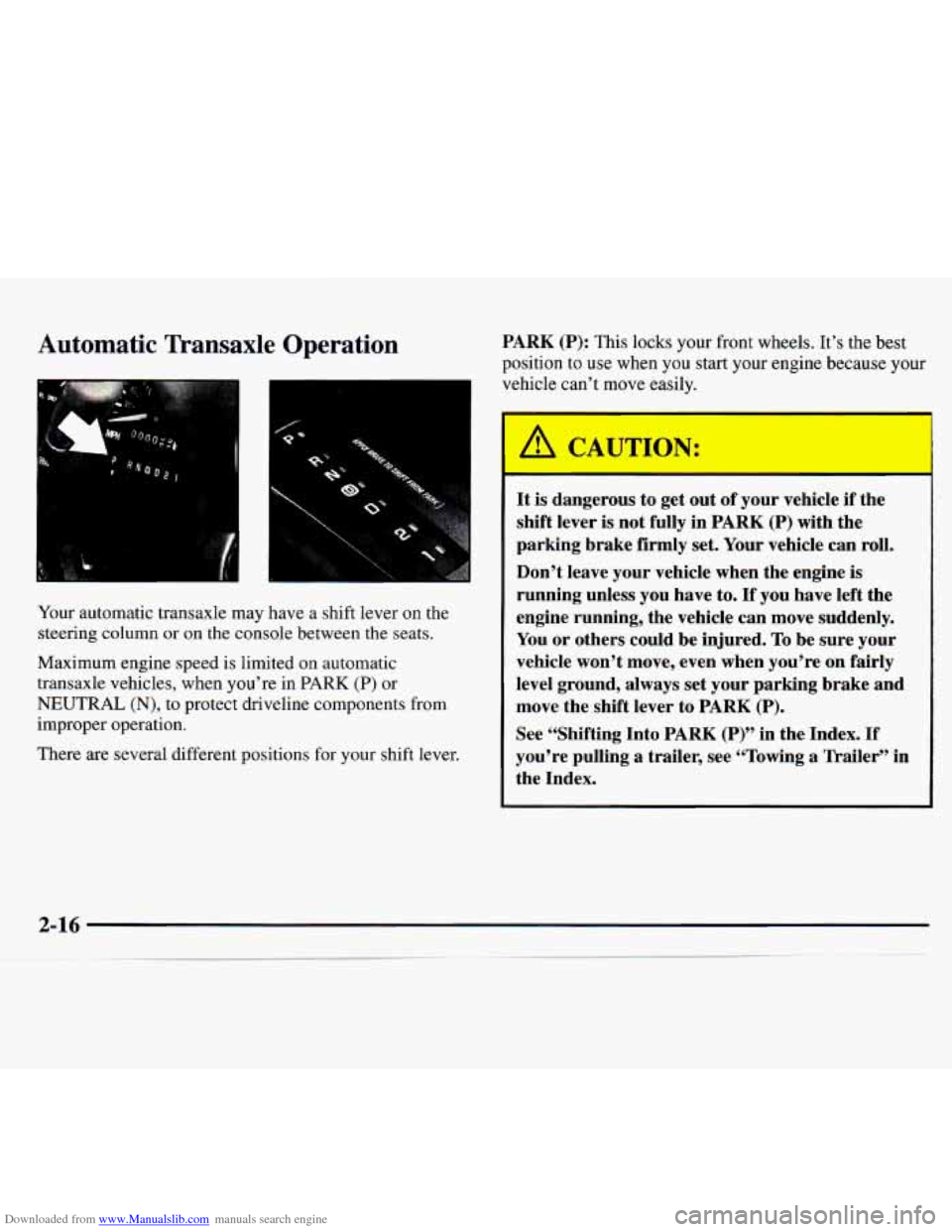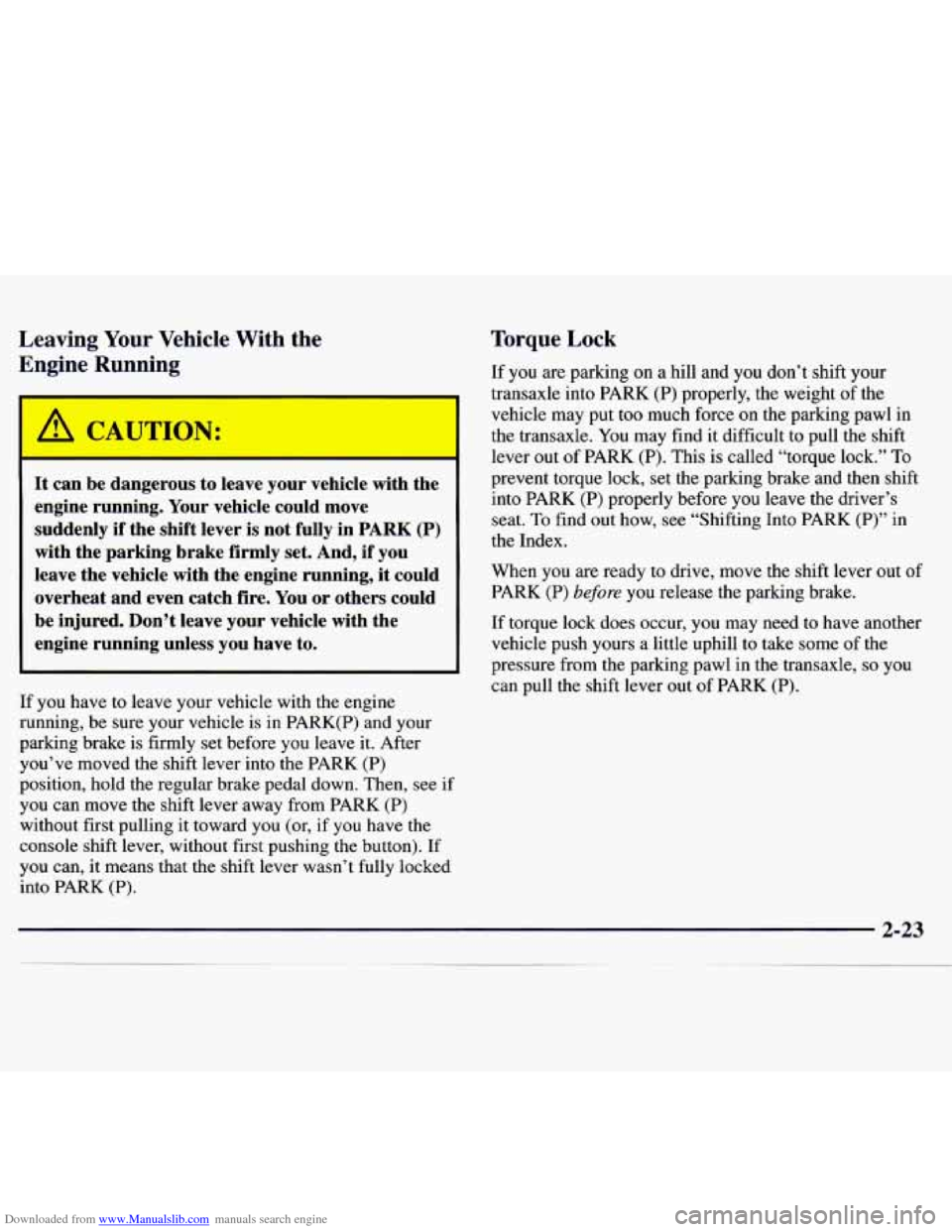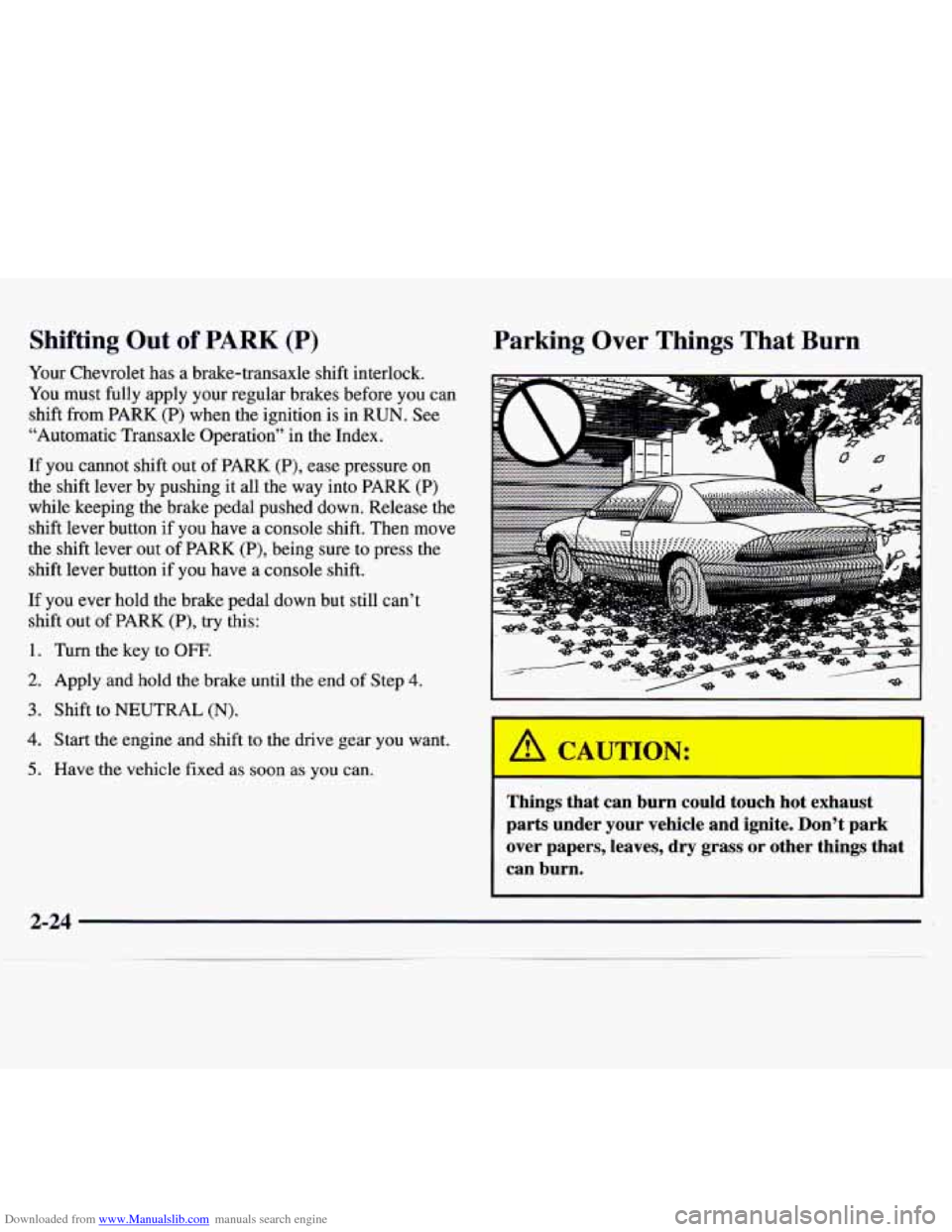Page 10 of 358

Downloaded from www.Manualslib.com manuals search engine Supplement to the 1997 Chevrolet Lumina and Monte Carlo Owner’s Manuals
This is a correction to information found on page 2-34 and 2-35 (Lumina) and page 2-34 (Monte Carlo).
Daytime Running Lamps / Automatic
Headlamp Control
Daytime Running Lamps (DRL) can make it easier
for others to
see the front of your vehicle during the
day. DRL can be helpful in
many different dnving
conditions, but they can be especially helpful in the
short periods after dawn and before sunset.
A light sensor on top of the instrument panel makes
the DRL work,
so be sure it isn’t covered.
The DRL system will make your high-beam headlamps
come on at a reduced brightness when:
The ignition is on,
The headlamp switch is off and
The parking brake is released.
97LUMWCARL0001 When
the DRL
are on, only your reduced intensity
high-beam headlamps will be on. The taillamps,
sidemarker and other lamps won’t be on. Your
instrument panel won’t be
lit up either.
When it’s dark enough outside, your DRL will turn off
and your low-beam headlamps will turn on. The other
lamps that come on with your headlamps will also
come on.
When it’s bright enough outside, the low-beam
headlamps will go out and DRL turns on your
high-beam headlamps at reduced intensity.
To idle your vehicle with the DRL off, set the parking
brake while the ignition is in
OFF or LOCK. Then start
your vehicle. The DRL will stay off until you release
the parking brake.
As with any vehicle, you should turn on the regular
headlamp system when you need it.
1
Page 60 of 358

Downloaded from www.Manualslib.com manuals search engine 0 Section 2 Features and Controls
Here you can learn about the many standard and optional features on your Chevrolet, and information on starting,
shifting and braking. Also explained are the instrument panel and
the warning systems that tell you if everything is
working properly -- and what to do if you have a problem.
2-2
2-4
2-5
2-8
2-9
2-10
2-12 2-12 2-13
2-15
2-16
2-20
2-2
I
2-24
2-24
2-25
2-25
Keys
Door Locks
Remote Keyless Entry (If Equipped)
Trunk
Theft PASS-Key@ I1
New Vehicle “Break-In”
Ignition Positions
Starting Your Engine
Engine Coolant Heater (Option)
Automatic Transaxle Operation
Parking Brake
Shifting Into PARK
(P)
Shifting Out of PARK (P)
Parking Over Things That Burn
Engine Exhaust
Running Your Engine While You’re Parked
2-26
2-27
2-27 2-27
2-33
2-35
2-36
2-3 8
2-40
2-40
2-42
2-43
2-44
2-46
2-48
Power Windows
Horn
Tilt Steering Wheel
Turn SignaVMultifunction Lever
Exterior Lamps Interior Lamps
Mirrors Storage Compartments
Ashtrays and Lighter
Sun Visors
Auxiliary Power Connection
Sunroof (Option)
Instrument Panel
-- Your
Information System
Instrument Panel Cluster
Warning Lights, Gages and Indicators
Page 75 of 358

Downloaded from www.Manualslib.com manuals search engine Automatic Transaxle Operation
Your automatic transaxle may have a shift lever on the
steering column
or on the console between the seats.
Maximum engine speed is limited on automatic
transaxle vehicles, when you’re in
PARK (P) or
NEUTRAL (N), to protect driveline components from
improper operation.
There are several different positions for your shift lever. PARK
(P): This locks your front
wheels. It’s the best
position to
use when you start your engine because your
vehicle can’t move easily.
I
It is dangerous to get out of your vehicle if the
shift lever is not fully in PARK
(P) with the
parking brake firmly set. Your vehicle can roll.
Don’t leave your vehicle when the engine
is
running unless you have to. If you have left the
engine running, the vehicle can move suddenly.
You or others could be injured.
To be sure your
vehicle won’t move, even when you’re on fairly
level ground,
always set your parking brake and
move the shift lever to PARK
(P).
See “Shifting Into PARK (P)” in the Index. If
you’re pulling a trailer, see “Towing a Trailer” in
the Index.
Page 79 of 358
Downloaded from www.Manualslib.com manuals search engine Parking Brake
To set the parking brake,
hold the regular brake pedal
down with your right foot.
Push down the parking
brake pedal with your
left foot.
To release the parking brake, hold the regular brake
pedal down with your right foot and push the parking
brake pedal with your left foot. When you lift your left
foot, the parking brake pedal will follow it to the
released position.
I NOTICE:
Driving with the parking brake on can cause
your rear brakes
to overheat. You may have to
replace them, and you could also
damage other
parts
of your vehicle.
If you are towing a trailer and are parking on any hill,
see “Towing a Trailer” in the Index. That section shows
what to do first to keep the trailer from moving.
Page 80 of 358
Downloaded from www.Manualslib.com manuals search engine Shifting Into PARK (P) Column Shift
It can be dangerous to get out of your vehicle if
the shift lever is not fully in
PARK (P) with the
parking brake firmly set. Your vehicle can roll.
If you have left the engine running, the vehicle
can move suddenly. You or others could be
injured.
To be sure your vehicle won’t move, even
when you’re on fairly level ground, use the steps
that follow.
If you’re pulling a trailer, see
“Towing
a Trailer” in the Index.
1. Hold the brake pedal down with your right foot and
2. Move the shift lever into PARK (P) position
set
the parking brake.
like this:
0 Pull the lever toward you.
2-21
- l__l_l
Page 81 of 358
Downloaded from www.Manualslib.com manuals search engine Move the lever up as far as it will go.
3. Move the ignition key to LOCK.
4. Remove the key and take it with you. If you can
leave your vehicle with the ignition key in your
hand, your vehicle is in PARK
(P).
Console Shift
1. Hold the brake pedal down with your right foot and
2. Move the shift lever into PARK (P) position
set
the parking brake.
like this:
Hold in the button on the
lever, and push the lever all
the way toward the front of
your vehicle.
3. Move the ignition key to LOCK.
4. Remove the key and take it with you. If you can
leave your vehicle with the ignition key in your
hand, your vehicle is in
PARK (P).
Page 82 of 358

Downloaded from www.Manualslib.com manuals search engine Leaving Your Vehicle With the
Engine Running
A C ,UTIOP‘
-
It can be dangerous to leave your vehicle with the
engine running. Your vehicle could move
suddenly if the shift lever is not fully in
PARK (P)
with the parking brake firmly set. And, if you
leave the vehicle with the engine running, it could overheat and even catch fire.
You or others could
be injured. Don’t leave your vehicle with the
engine running unless you have to.
If you have to leave your vehicle with the engine
running, be sure your vehicle is in PARK(P) and your
parking brake
is firmly set before you leave it. After
you’ve moved the shift lever into the PARK (P)
position, hold the regular brake pedal down. Then, see if
you can move the shift lever away from PARK
(P)
without first pulling it toward you (or, if you have the
console shift lever, without first pushing the button). If
you can, it means that the shift lever wasn’t fully locked
into PARK (P).
Torque Lock
If you are parking on a hill and you don’t shift your
transaxle into PARK (P) properly, the weight of the
vehicle may put
too much force on the parking pawl in
the transaxle. You may find it difficult to pull the shift
lever out of PARK (P). This is called “torque lock.”
To
prevent torque lock, set the parking brake and then shift
into PARK
(P) properly before you leave the driver’s
seat.
To find out how, see “Shifting Into PARK (P)” in
the Index.
When you
are ready to drive, move the shift lever out of
PARK
(P) before you release the parking brake.
If torque lock does occur, you may need to have another
vehicle push yours a little uphill to take some of the
pressure from the parking pawl in the transaxle,
so you
can pull the shift lever out of PARK (P).
Page 83 of 358

Downloaded from www.Manualslib.com manuals search engine Shifting Out of PARK (P)
Your Chevrolet has a brake-transaxle shift interlock.
You must fully apply your regular brakes before you can
shift from PARK (P) when the ignition
is in RUN. See
“Automatic Transaxle Operation” in the Index.
If you cannot shift out of PARK (P), ease pressure
on
the shift lever by pushing it all the way into PARK (P)
while keeping the brake pedal pushed down. Release the
shift lever button if you have a console shift. Then move
the shift lever out of PARK
(P), being sure to press the
shift lever button if
you have a console shift.
If you ever hold the brake pedal down but still can’t
shift out
of PARK (P), try this:
1.
2.
3.
4.
5.
Turn the key to OFF.
Apply and hold the brake until the end of Step 4.
Shift to NEUTRAL (N).
Start the engine and shift to the drive gear you want.
Have the vehicle fixed
as soon as you can.
Parking Over Things That Burn
Things that can burn could touch hot exhaust
parts under your vehicle and ignite. Don’t park
over papers, leaves, dry grass
or other things that
can burn.
2-24